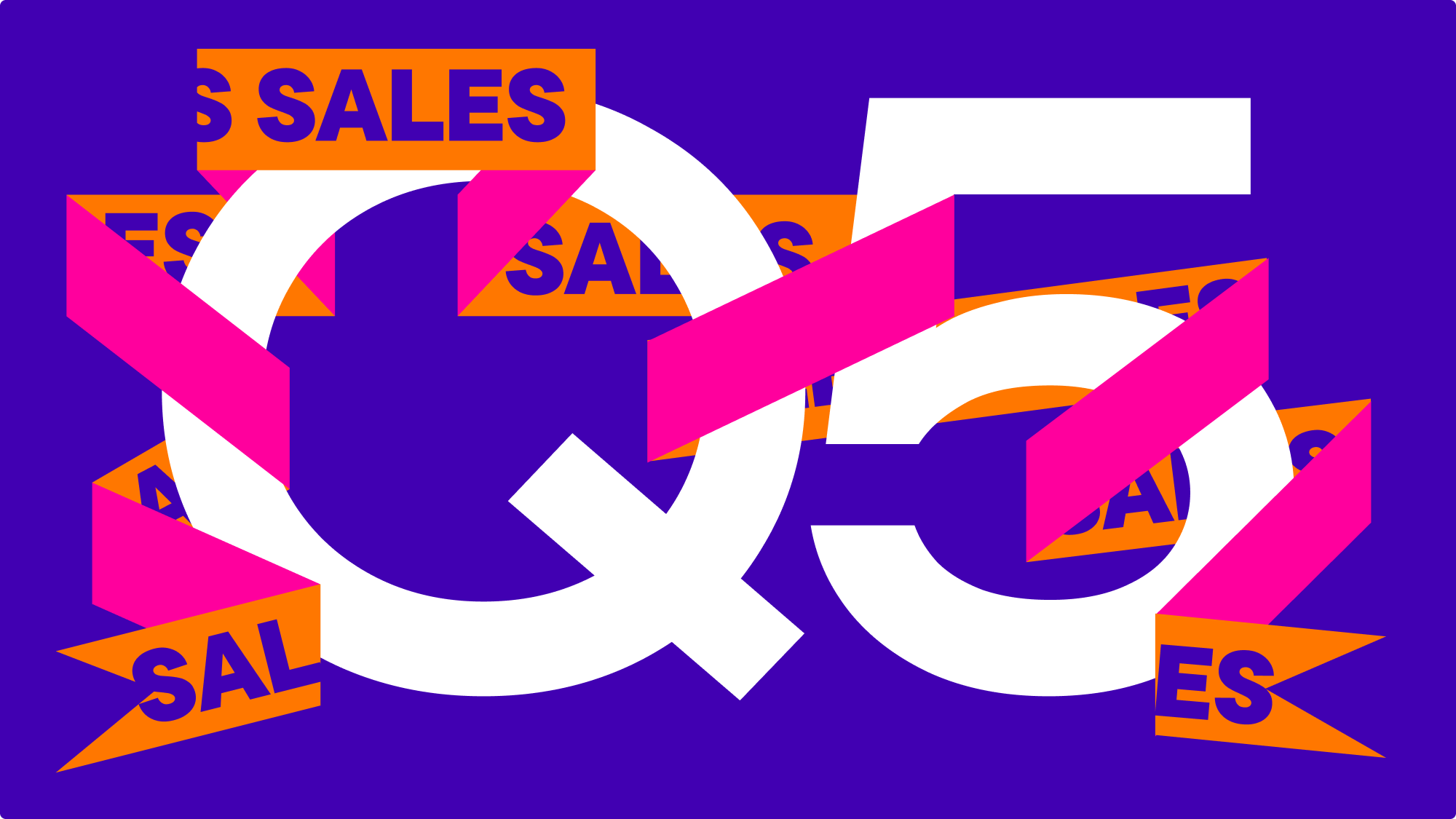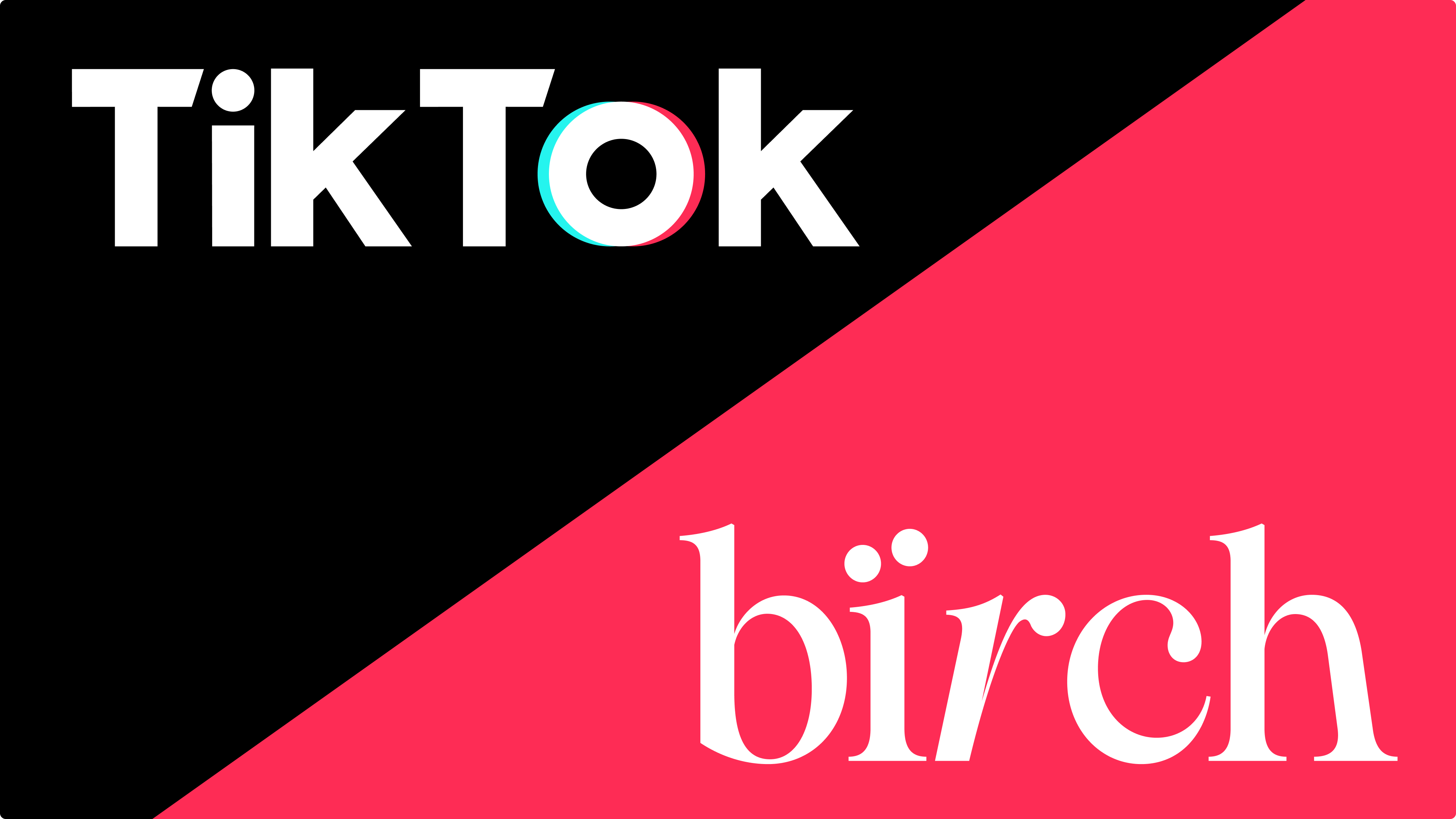In today’s digital landscape, mobile apps have become more than just an extension of a brand; they often serve as the primary interface between a business and its customers. With over 5 million apps available on the App Store and Google Play combined, breaking through the noise requires more than just a large media budget. Success demands precision, creative agility, and a deep integration between product, marketing, and analytics teams.
Unlike traditional advertising, mobile app marketing depends on user actions that extend beyond just the installation of the app. The true measure of a campaign’s success isn’t solely based on cost per install (CPI), but rather on post-install metrics like retention, engagement, and return on ad spend (ROAS). Consequently, performance marketing in the app ecosystem requires a strategic shift from focusing on vanity metrics to prioritizing actionable outcomes.
Additionally, the ecosystem is evolving rapidly. Apple’s App Tracking Transparency (ATT) and Google’s Privacy Sandbox are changing how marketers access user-level data. These shifts are leading the industry toward probabilistic measurement, aggregated reporting, and privacy-safe optimization techniques, such as SKAdNetwork and modeled lifetime value (LTV) predictions.
For marketers aiming to scale app growth in 2026 and beyond, understanding this complex landscape is critical. Bïch provides a guide covering aspects from campaign architecture to creative testing, budgeting, and analytics.
Key Takeaways
- Success is measured post-install. Installs are just the beginning. True performance marketing for apps focuses on retention, engagement, LTV, and ROAS—not just CPI.
- Advertising strategy must align with the app lifecycle. Different stages (MVP, growth, maturity) require distinct goals and tactics, from broad testing to ROAS optimization and retargeting.
- Privacy changes demand new attribution methods. Marketers must now rely on SKAdNetwork, probabilistic modeling, and MMPs for user tracking, event mapping, and optimization.
- App Store Optimization (ASO) impacts paid performance. Store pages act as conversion points. Consistent creative messaging, quality visuals, and A/B-tested assets directly influence install rates.
- Creative testing is essential for growth. Performance hinges on fresh, high-velocity creative iteration. Ads must match platform formats and be continuously tested and refreshed.
- Channel strategy requires diversification. Use a core + experimental model. Tailor creatives to each platform and compare results via normalized data from MMPs.
- Budgeting and bidding must be dynamic. Begin with tCPA, transition to tROAS as data matures. Allocate spend by funnel stage, and scale based on performance signals like D30 ROAS.
- Deep linking and web2app funnels boost conversion. Seamless user journeys via deep links and attribution through web2app strategies maximize campaign efficiency and UX.
- Retargeting should be precise and respectful. Segment by user behavior and dormancy. Use deep links and frequency caps to prevent fatigue and enhance re-engagement.
- Team structure drives execution. High-performing UA teams need defined roles (UA manager, creative strategist, ASO lead, data analyst) and agile creative pipelines to sustain scale and performance.
The unique dynamics of mobile app advertising
Marketing a mobile app is fundamentally different from promoting traditional web products. Although the goal remains user acquisition and conversion, the process is influenced by mobile-specific challenges, fragmented user journeys, and platform limitations.
Why installs alone aren’t sufficient
An install is just the starting point. Effective campaigns must focus on post-install performance, as user value is truly achieved only when users engage, retain, and monetize. Key metrics to consider include:
- Day 1 / Day 7 / Day 30 retention — Onboarding success and stickiness
- Session depth — Engagement with core features
- Trial or purchase conversion — Monetization health
- LTV (lifetime value) — Revenue across user lifespan
- ROAS (return on ad spend) — The ultimate metric for scalability
Focusing on CPI alone leads to false positives and wasted budget. True performance lies beyond the install.
Aligning with the product life cycle
Different app lifecycle stages require different ad strategies:
A common mistake is treating all phases the same. For instance, hyper-targeting too early limits learning and reach.
Attribution and privacy-first measurement
Since iOS 14.5, marketers can no longer rely on deterministic tracking. Instead, success depends on:
- SKAdNetwork (SKAN) — Apple’s aggregated attribution system
- Conversion value mapping — Carefully designed funnels
- Probabilistic modeling — Still viable on Android (with caution)
- Mobile measurement partners (MMPs) — Adjust, AppsFlyer, Branch and others.
Event-level tracking (e.g., install → registration → purchase) enables smarter optimization.
App store experience affects paid performance
Your store listing is a conversion page. Even great ads won’t convert if the app store experience is inconsistent or unoptimized. Common pitfalls include:
- Inconsistent creative messaging
- Low-quality visuals or outdated screenshots
- Poor ratings and few reviews
- Weak keyword optimization
Checklist for alignment
- Consistent language between ad and store
- A/B tested icons, titles, and screenshots
- Compelling social proof (ratings, awards)
- Optimized metadata for ASO
The role of ASO and app store landing pages in advertising
App Store Optimization (ASO) is frequently viewed as a strategy solely for organic growth. However, it is equally important for paid acquisition. Every advertising campaign ultimately directs users to an app store listing, which serves as a conversion point. If this page is not well optimized, even the most effective ads may fail to deliver satisfactory results.
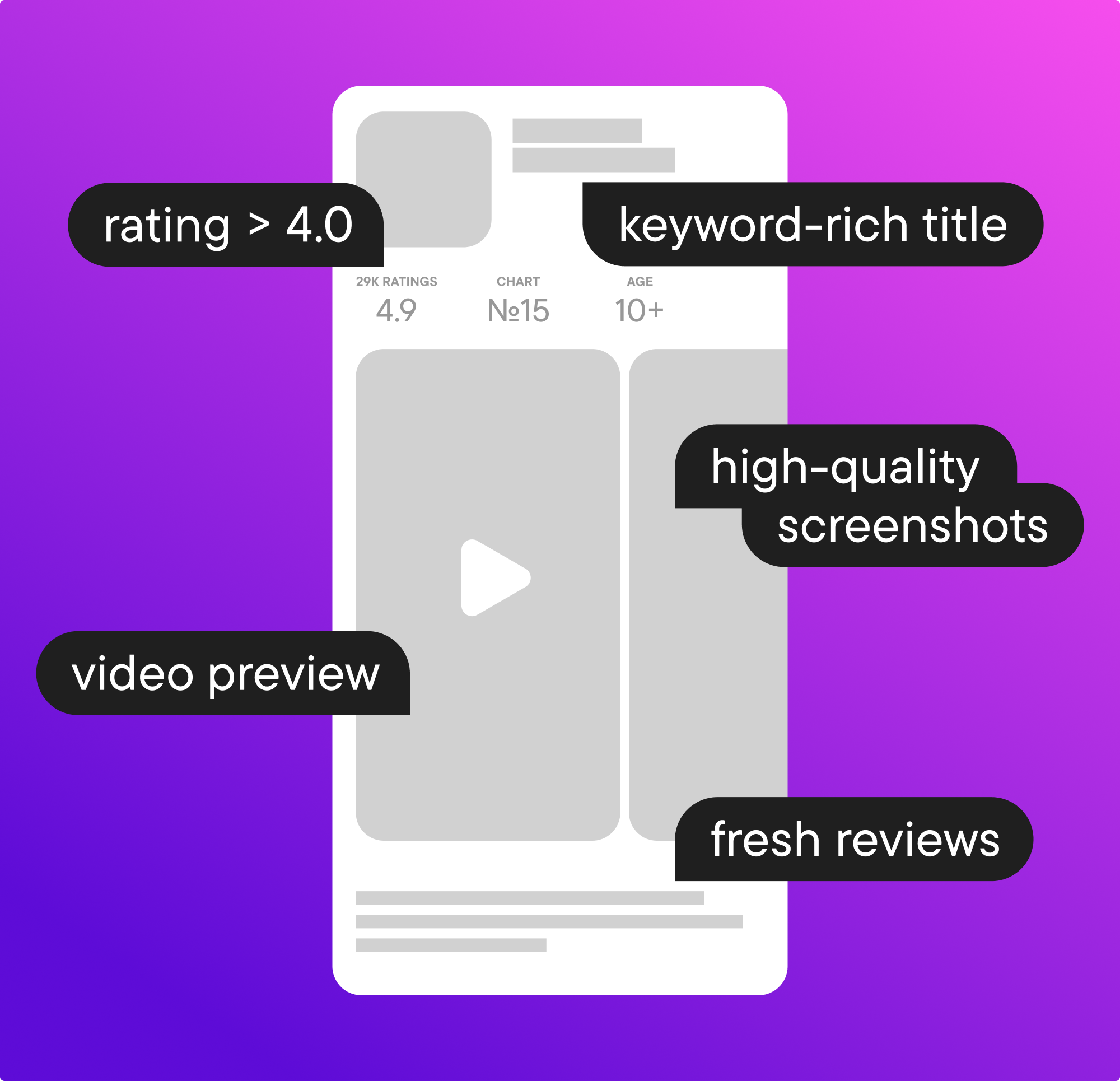
Why ASO matters for paid campaigns
ASO doesn’t just drive discoverability. It influences:
- Conversion rate from ad click to install
- Relevance scores in platforms like Apple Search Ads
- Perceived app quality through visuals and reviews
- Alignment between user expectations and product offer
Studies show that optimizing store assets can improve paid install rates by 20–40%, even with unchanged targeting or creatives.
Creative consistency across the funnel
A common reason for users abandoning the download process is a disconnect between the advertisement and the app store content. For instance, if your ad highlights a specific feature or benefit that is not clearly reflected in the store listing, users may lose trust and decide not to proceed.
Ensure alignment by:
- Using the same headline hooks and visuals in ads and store assets
- Testing icon styles that match ad branding
- Featuring user testimonials or awards shown in creatives
- Including videos that mirror the in-ad experience
ASO checklist for paid media support
Before launching performance campaigns, ensure your store presence is conversion-optimized:
- Keyword-rich title and subtitle
- High-quality, branded screenshots
- Video preview that reflects product flow
- Ratings above 4.0 (or strategy to improve them)
- Fresh and relevant reviews
- Consistency across app versions, locales, and platforms
Treat the store page as part of the ad itself—not just a destination. ASO is no longer a separate discipline from user acquisition. It is a multiplier. Every improvement to your app store listing makes your paid campaigns more efficient and your users more likely to convert.
Channels and platforms: where to advertise and why
Choosing the right advertising platforms is one of the most strategic decisions in mobile user acquisition. Each channel has its strengths, audience behaviors, and optimization models.
Major performance ad platforms
The “big four” still dominate paid app marketing:
Each platform requires platform-specific creatives and bid strategies. Meta, for example, works best when optimizing for custom in-app events, while Apple Search Ads thrives on keyword targeting.
Second-tier and emerging channels
Beyond the major players, many marketers explore high-performing niche platforms, especially during scaling or when reaching non-standard markets:
- Unity Ads / ironSource / AdColony — Ideal for gaming apps (rewarded video, interstitials)
- Huawei Ads — Growing in regions like Eastern Europe and Asia
- Mintegral / Vungle / Chartboost — Effective for programmatic and video-first strategies
- Reddit Ads — High engagement for niche communities
- Snapchat Ads — Young audience, rapid testing capabilities
These networks can offer lower CPI and a more loyal user base when tailored well to the product.
How to mix channels effectively
Multi-channel strategies perform best when:
- Ad creative is customized per platform (style, length, message)
- Budget allocation is based on post-install metrics, not just install volume
- Data is normalized through an MMP to compare ROAS across networks
- SKAdNetwork postbacks are collected and modeled centrally
Many marketers use a "core + experimental" budget model—allocating 80% to proven platforms and 20% to testing new ones.
Creative testing and hypothesis validation
In mobile app advertising, creatives are your engine of growth. No matter how optimized your targeting or bidding is, tired or irrelevant ads will stall performance. That’s why high-velocity creative testing is critical—not just for engagement, but for sustainable ROAS.
Creative formats that convert
Different platforms favor different creative styles:
The creative testing process
Effective marketers treat creative production like an agile sprint process. A structured approach looks like this:
Hypothesis formation
- “A shorter CTA will improve click-through”.
- “UGC format outperforms animated walkthrough”.
Batch creation (3–5 variants per test)
- Same value prop, different framing (tone, design, CTA)
Platform-appropriate A/B testing
- TikTok: Spark Ads vs. regular ads
- Meta: Creative split test campaigns
- Apple Search Ads: less visual flexibility, more copy focus
Analysis & scale
- Kill underperformers early (IPM < 20, CTR < 0.5%)
- Promote creatives with high CVR & low cost-per-purchase
Read more about creative testing in our guide. And use Bïrch (formerly Revealbot) to effectively test your mobile app ads.
Signs of creative fatigue
Even great creatives burn out. You may be hitting fatigue if you notice:
- Declining CTR
- Increasing CPM or CPC despite steady audience size
- Drop in ROAS or LTV over time
- Repeated users skipping or hiding your ad
Solutions:
- Rotate creatives every 7–14 days (depending on spend)
- Repurpose top-performers into new variants
- Use creative clusters: same concept, multiple executions
Analytics and tracking tools for mobile advertising
Choosing the right advertising platforms is one of the most strategic decisions in mobile user acquisition. Each channel has its own strengths, audience behaviors, and optimization models. Understanding these nuances helps marketers avoid overspending on low-value users and ensures they don’t miss out on growth opportunities.
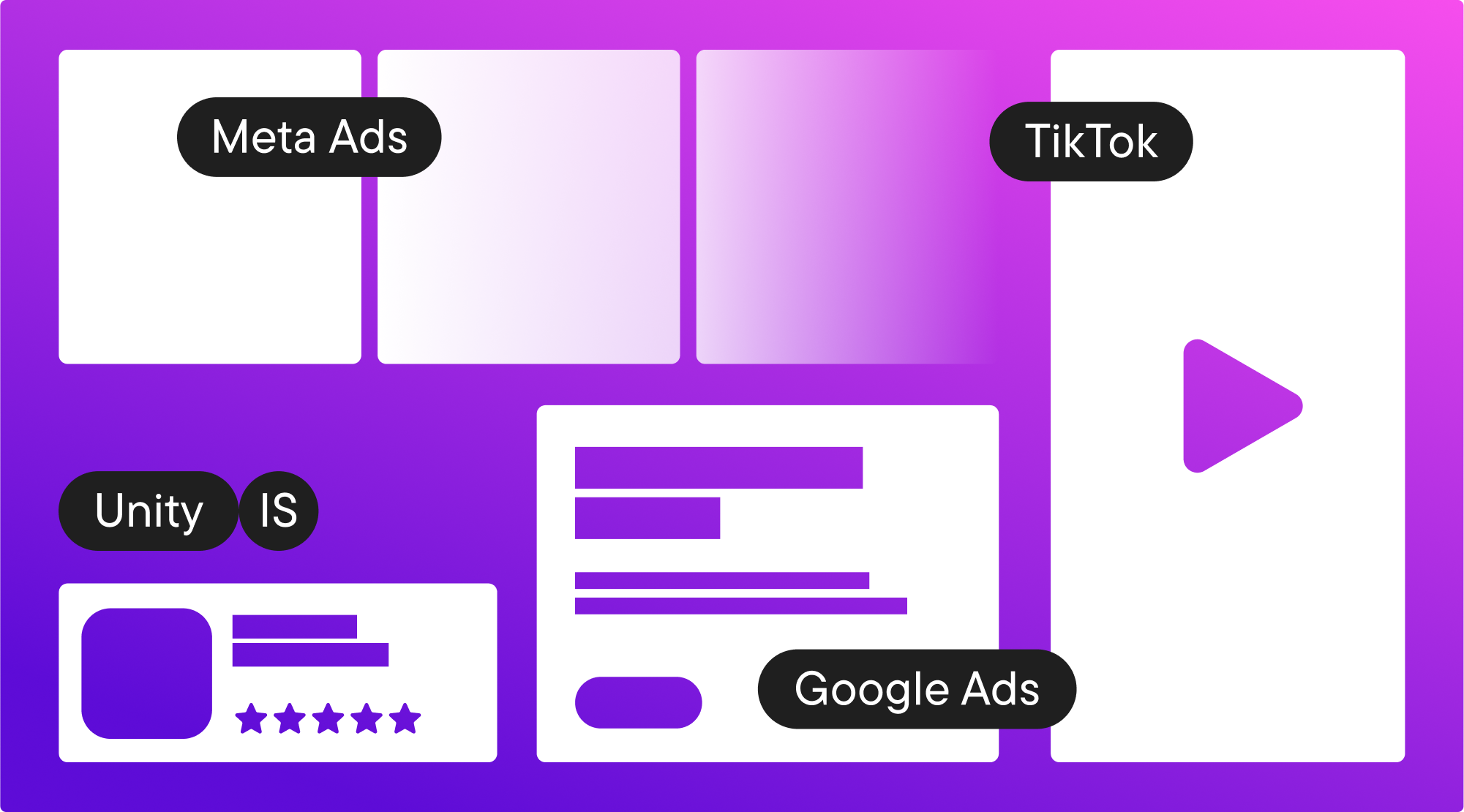
What is an MMP and why you need it
A Mobile Measurement Partner (MMP) is a third-party platform that consolidates campaign data from multiple ad networks and attributes installs and in-app events accurately via SDKs. MMPs like Adjust and AppsFlyer act as the unbiased source of truth for marketing performance.
Key benefits:
- Unified attribution across channels — US IDs, probabilistic modeling, and SKAdNetwork
- Cross-platform event tracking — Enables deeper funnel analysis
- Real-time ROAS and LTV dashboards
- Anti-fraud protection and clean datasets
In-app event tracking and measurement strategy
Successful analytics starts with clear event definitions:
- Define standardized events (e.g., registration, purchase) across Android and iOS.
- Configure deep funnel tracking – install → open → register → purchase → subscribe
- Map events via SKAN conversion schema for iOS aggregated modeling
- Report raw and aggregate data for cohort analysis and retention insight
This ensures consistent metrics across campaigns and platforms.
Comparing analytics platforms
Many teams pair an MMP for marketing data and a second tool for UX/product analysis.
Best practices for analytics-driven campaigns
- Hook analytics into campaign workflows: attribution must signal into bid optimization and budget allocation.
- Segment by cohort: compare ARPU/LTV by install date, source, creative.
- Sync SKAdNetwork data daily for adjusted performance signals.
- Run incrementality tests: use holdout groups to measure lift per channel.
- Audit and iterate: review event naming, SDK versions, anti-fraud thresholds quarterly.
The funnel framework: from pre-launch to retargeting
To maximize ROI, app marketers should adopt a layered funnel approach, from pre-launch testing to hard launch optimization and retention-driven retargeting.
Pre‑launch: technical validation and teaser campaigns
Before any full release, build awareness and test systems:
- Deploy teaser ads (on TikTok, Instagram, YouTube) to assess interest and messaging.
- Confirm infrastructure readiness (server response, app stability).
- Collect leads or email sign-ups via landing pages.
Soft launch: early performance and iteration
Soft launch brings the app to a limited audience (1–2 countries) to:
- Test onboarding flow, early retention (D1, D7), and ASO effects
- Gain initial user feedback and detect friction points
- Evaluate monetization viability and target CPIs
Studies show soft launches can reduce acquisition costs by ~90% and improve ASO keyword intelligence
Hard launch: scale when metrics align
Once soft launch KPIs hit benchmarks:
- Scale aggressively in core markets (US, EU, large APAC regions)
- Execute mass media campaigns—press, influencers, paid ads
- Monitor performance in real-time: installs, LTV, and ROAS
A hybrid approach combining phased soft launch with hard launch often yields best results
Retargeting: boosting LTV and retention
After acquisition, focus on value generation:
- Segment users: new, dormant, high-LTV
- Build promo and feature-upgrade flows to entice re-engagement
- Use deep links and in-app messaging to direct users to relevant screens
- Leverage lookalikes based on retained users to scale profitably
Summary table
Budgeting and bidding: optimizing spend for scale and efficiency
Effective budgeting and bid strategy is a core skill for mobile UA leads—ensuring campaigns both scale and drive profit.
Choosing the right automated bid model
Modern UA relies on smart bidding strategies tied to campaign goals:
- tCPA (target cost per action/install) – optimized to keep desired cost per install or in-app action; ideal for consistent cost targets
- tROAS (target return on ad spend) – bids based on revenue potential, ideal when LTV is predictable.
- Best long-term approach: start with tCPA, as data builds, transition to tROAS for ROI focus.
Google recommends setting tCPA ~1.5× higher on iOS vs Android and using tROAS % based on historical revenue-cost ratio
Budget allocation and dynamic flow
Budgeting should be fluid, data-driven:
- Set efficiency thresholds (e.g., CPI ≤ €2, D30 ROAS ≥ 1.5×)
- Scale budgets where metrics meet targets
- Pause or reallocate any channels exceeding thresholds by ~10–15%
- Forecast spend capacity: if LTV30 = €5 and CPI = €2.50, scale up to 2× budget per channel.
This system matches resource allocation to performance dynamically.
Funnel-aware budgeting
Split budgets based on funnel stage:
- Pre-launch/soft launch: small budget for testing creatives and markets
- Hard launch: major spend on scaled channels (Meta, Google, Apple Search)
- Post-install stage: specific funds for retargeting and ROAS campaigns
- Funnel-aware budgeting reduces risk of overspending ineffective stages.
Scaling with LTV prediction
Platforms like AppNava show that LTV-predictive bidding—where high-value user segments receive higher bids—can boost efficiency by letting marketers bid more precisely.
Combining LTV-based optimization with funnel insights allows you to scale profitably, not just at volume.
Avoiding common pitfalls
Don’t use bid caps on automated strategies—they limit AI performance.
Match lookback windows to app behavior—longer windows for slower LTV realization.
Adopt tROAS only once stable LTV data is available—forcing it prematurely hurts growth.

Deep linking, SKAdNetwork and web2app funnels
Effective mobile acquisition now requires three core elements working in harmony: deep links to streamline user journeys, SKAdNetwork (SKAN) for privacy-compliant attribution, and web‑to‑app funnels to tap traffic beyond app stores.
Deep linking: seamless user journeys
Deep linking directs users straight to relevant in‑app content (e.g. product page, onboarding screen), dramatically improving conversion and engagement. Deferred deep links work even when the app isn’t installed: users click a link → install → open → land directly in context.
Best practices include:
- Configuring both URI schemes and Universal/App Links
- Setting solid fallback URLs to the store or web
- Branding links and using smart routing tools for tracking
SKAdNetwork: privacy-first attribution
Apple’s SKAdNetwork (SKAN) delivers aggregated, privacy-safe postback data. With SKAN 4.0+, features include multiple postbacks over time, source IDs, and coarse/fine conversion values—enabling richer insights while respecting user privacy.
To maximize SKAN utility:
- Map in‑app events into conversion‑value schemas
- Cohesive campaign setup across networks to avoid privacy thresholds
- Use modeled analytics to reconstruct missing data singular.net+1branch.io+1
web2app funnels: bridging web and app
Web campaigns (e.g. ads, email, QR) can now direct users into the app via a short web-to-app funnel:
- Ad click lands on intermediate page that saves attribution
- Directs to store → install → opens with context inserted via deferred link
- MMP captures source and funnels event data back
This strategy captures upper-funnel intent and increases ROAS by unifying web and app metrics.
Summary
Combine deep links with SKAN-aware campaigns and web2app funnels to ensure that acquisition efforts—from ad click to in-app conversion—are cohesive, measurable, and optimized for real business outcomes.
Errors, fatigue and ad refresh strategies
Even the most robust UA campaigns can falter due to creative fatigue, targeting errors, or repetitive funnels. This chapter focuses on preventing performance decay and maintaining consistent efficiency.
Recognizing errors and fatigue symptoms
Frequent issues include:
- Creative fatigue: CTR or IPM declines, CPC/CPA increases, diminishing ROAS, even as impression counts rise
- Ad fatigue: Overexposure of the same creative to the same audience, flagged by platforms (e.g., Meta’s “Creative fatigue” alert)
- Targeting errors: Audience pool too narrow leading to quick saturation, or excessive frequency without recall thresholds
Preventive and corrective tactics
❌ Problem: Creative or ad fatigue
✅ Solution: Refresh creative every 7–14 days
❌ Problem: Repeated targeting
✅ Solution: Expand or rotate audiences
❌ Problem: Over frequency
✅ Solution: Apply frequency caps (e.g., 3× per week)
❌ Problem: Performance drop
✅ Solution: Introduce new formats: video, dynamic, user-generated
Creative rotation and testing
- Plan rotations proactively: map at least 3 variants per campaign, refreshing on time
- Use dynamic creative optimization via ad platforms or DSPs to combine assets programmatically
- Set frequency caps and make sure creative pools exceed them — this avoids overexposure
Retargeting with precision
Retargeting requires segmentation and timing:
- Identify dormancy periods (e.g., 7, 14, 30 days post-install)
- Segment audiences by behavior (e.g., viewed product, added to cart)
- Use deep links to bring users to the exact in-app screen
- Respect frequency: aggressive caps prevent user fatigue
Checklist
- Monitor CTR, CPC/CPA, ROAS, impression trends, and frequency
- Prepare multiple creative variants across formats
- Employ frequency capping with buffer rotation
- Segment and personalize retargeting based on user behavior
- Use dynamic ads and creative testing to sustain user interest
Team structure and execution: scaling through process
Even the best ad strategies и budgets won’t deliver sustainable results without a robust team and well-defined processes. Performance in mobile UA depends on how effectively your people operate—setting up feedback loops, defining roles, and optimizing execution.
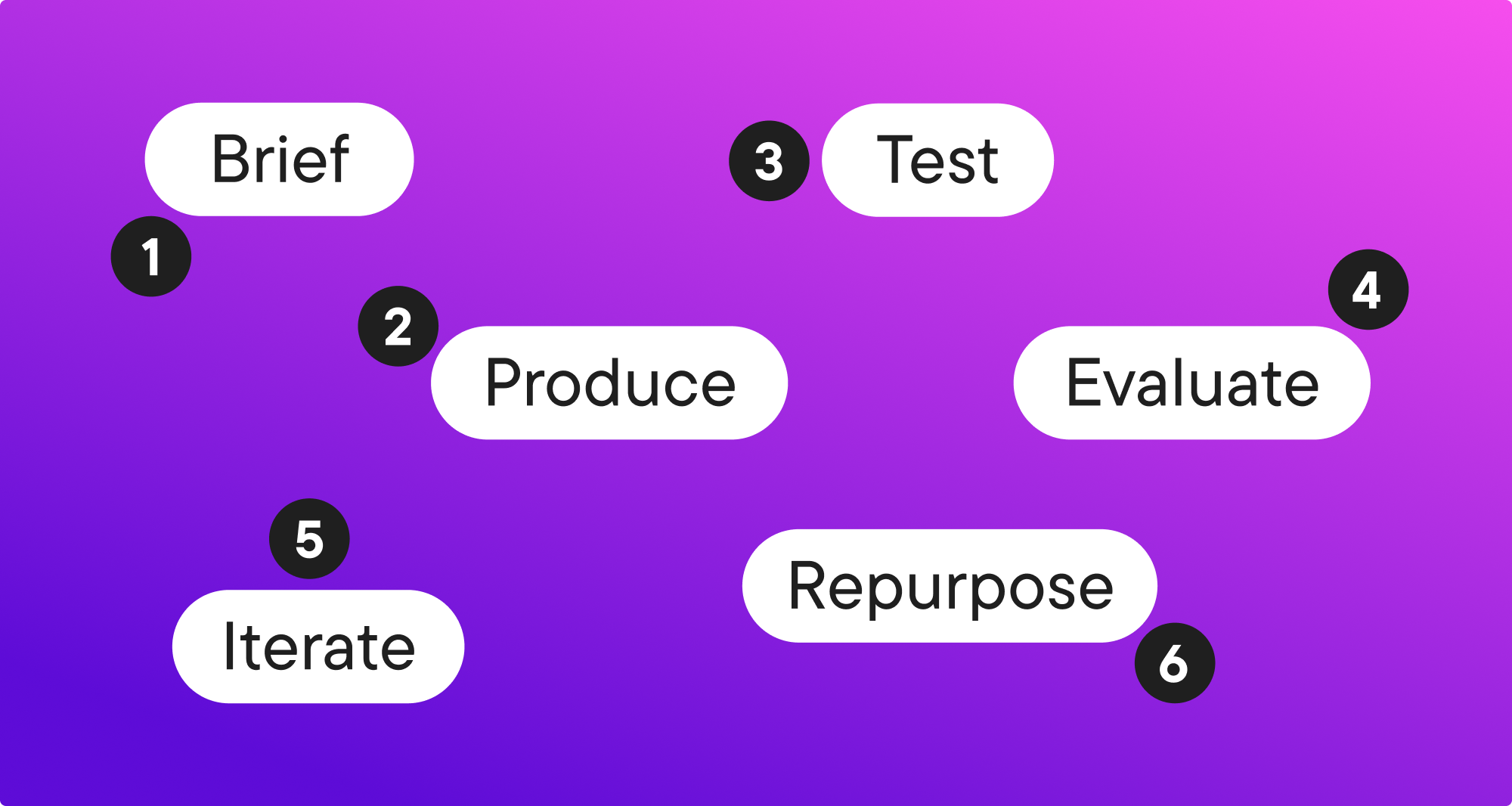
Defining key roles and structure
High-growth mobile UA teams typically align roles like this:
- UA manager — responsible for media buying, pacing, and performance KPIs
- Creative strategist — develops hypotheses, coordinates creative production
- Designer / motion editor —creates cross-platform ad formats
- ASO manager — enhances store listing to support paid performance
- Data analyst — builds dashboards, modeling LTV and incrementality
And a growth designer, for sure.
There are two common organizational models:
- Metric-tied squads: teams focused on stages like activation or retention
- Functional pods by channel: e.g. Meta, TikTok, ASA—central creative and analytics shared
Creative pipeline process
Efficient creative operations follow a sprint-like cycle:
- Brief — define hypothesis, target, format
- Produce — 3–5 ad variants per concept
- Test — run platform-specific splits or rotations
- Evaluate — review CVR, ROAS, engagement metrics
- Iterate — refine or kill based on data
- Repurpose — deploy winning creatives in new channels
FAQs
What happened to Revealbot?
Revealbot underwent a comprehensive rebrand and is now known as Bïrch. This transformation reflects our renewed focus on blending automation efficiency with creative collaboration.
In today’s digital landscape, mobile apps have become more than just an extension of a brand; they often serve as the primary interface between a business and its customers. With over 5 million apps available on the App Store and Google Play combined, breaking through the noise requires more than just a large media budget. Success demands precision, creative agility, and a deep integration between product, marketing, and analytics teams.
Unlike traditional advertising, mobile app marketing depends on user actions that extend beyond just the installation of the app. The true measure of a campaign’s success isn’t solely based on cost per install (CPI), but rather on post-install metrics like retention, engagement, and return on ad spend (ROAS). Consequently, performance marketing in the app ecosystem requires a strategic shift from focusing on vanity metrics to prioritizing actionable outcomes.
Additionally, the ecosystem is evolving rapidly. Apple’s App Tracking Transparency (ATT) and Google’s Privacy Sandbox are changing how marketers access user-level data. These shifts are leading the industry toward probabilistic measurement, aggregated reporting, and privacy-safe optimization techniques, such as SKAdNetwork and modeled lifetime value (LTV) predictions.
For marketers aiming to scale app growth in 2026 and beyond, understanding this complex landscape is critical. Bïch provides a guide covering aspects from campaign architecture to creative testing, budgeting, and analytics.
Key Takeaways
- Success is measured post-install. Installs are just the beginning. True performance marketing for apps focuses on retention, engagement, LTV, and ROAS—not just CPI.
- Advertising strategy must align with the app lifecycle. Different stages (MVP, growth, maturity) require distinct goals and tactics, from broad testing to ROAS optimization and retargeting.
- Privacy changes demand new attribution methods. Marketers must now rely on SKAdNetwork, probabilistic modeling, and MMPs for user tracking, event mapping, and optimization.
- App Store Optimization (ASO) impacts paid performance. Store pages act as conversion points. Consistent creative messaging, quality visuals, and A/B-tested assets directly influence install rates.
- Creative testing is essential for growth. Performance hinges on fresh, high-velocity creative iteration. Ads must match platform formats and be continuously tested and refreshed.
- Channel strategy requires diversification. Use a core + experimental model. Tailor creatives to each platform and compare results via normalized data from MMPs.
- Budgeting and bidding must be dynamic. Begin with tCPA, transition to tROAS as data matures. Allocate spend by funnel stage, and scale based on performance signals like D30 ROAS.
- Deep linking and web2app funnels boost conversion. Seamless user journeys via deep links and attribution through web2app strategies maximize campaign efficiency and UX.
- Retargeting should be precise and respectful. Segment by user behavior and dormancy. Use deep links and frequency caps to prevent fatigue and enhance re-engagement.
- Team structure drives execution. High-performing UA teams need defined roles (UA manager, creative strategist, ASO lead, data analyst) and agile creative pipelines to sustain scale and performance.
The unique dynamics of mobile app advertising
Marketing a mobile app is fundamentally different from promoting traditional web products. Although the goal remains user acquisition and conversion, the process is influenced by mobile-specific challenges, fragmented user journeys, and platform limitations.
Why installs alone aren’t sufficient
An install is just the starting point. Effective campaigns must focus on post-install performance, as user value is truly achieved only when users engage, retain, and monetize. Key metrics to consider include:
- Day 1 / Day 7 / Day 30 retention — Onboarding success and stickiness
- Session depth — Engagement with core features
- Trial or purchase conversion — Monetization health
- LTV (lifetime value) — Revenue across user lifespan
- ROAS (return on ad spend) — The ultimate metric for scalability
Focusing on CPI alone leads to false positives and wasted budget. True performance lies beyond the install.
Aligning with the product life cycle
Different app lifecycle stages require different ad strategies:
A common mistake is treating all phases the same. For instance, hyper-targeting too early limits learning and reach.
Attribution and privacy-first measurement
Since iOS 14.5, marketers can no longer rely on deterministic tracking. Instead, success depends on:
- SKAdNetwork (SKAN) — Apple’s aggregated attribution system
- Conversion value mapping — Carefully designed funnels
- Probabilistic modeling — Still viable on Android (with caution)
- Mobile measurement partners (MMPs) — Adjust, AppsFlyer, Branch and others.
Event-level tracking (e.g., install → registration → purchase) enables smarter optimization.
App store experience affects paid performance
Your store listing is a conversion page. Even great ads won’t convert if the app store experience is inconsistent or unoptimized. Common pitfalls include:
- Inconsistent creative messaging
- Low-quality visuals or outdated screenshots
- Poor ratings and few reviews
- Weak keyword optimization
Checklist for alignment
- Consistent language between ad and store
- A/B tested icons, titles, and screenshots
- Compelling social proof (ratings, awards)
- Optimized metadata for ASO
The role of ASO and app store landing pages in advertising
App Store Optimization (ASO) is frequently viewed as a strategy solely for organic growth. However, it is equally important for paid acquisition. Every advertising campaign ultimately directs users to an app store listing, which serves as a conversion point. If this page is not well optimized, even the most effective ads may fail to deliver satisfactory results.

Why ASO matters for paid campaigns
ASO doesn’t just drive discoverability. It influences:
- Conversion rate from ad click to install
- Relevance scores in platforms like Apple Search Ads
- Perceived app quality through visuals and reviews
- Alignment between user expectations and product offer
Studies show that optimizing store assets can improve paid install rates by 20–40%, even with unchanged targeting or creatives.
Creative consistency across the funnel
A common reason for users abandoning the download process is a disconnect between the advertisement and the app store content. For instance, if your ad highlights a specific feature or benefit that is not clearly reflected in the store listing, users may lose trust and decide not to proceed.
Ensure alignment by:
- Using the same headline hooks and visuals in ads and store assets
- Testing icon styles that match ad branding
- Featuring user testimonials or awards shown in creatives
- Including videos that mirror the in-ad experience
ASO checklist for paid media support
Before launching performance campaigns, ensure your store presence is conversion-optimized:
- Keyword-rich title and subtitle
- High-quality, branded screenshots
- Video preview that reflects product flow
- Ratings above 4.0 (or strategy to improve them)
- Fresh and relevant reviews
- Consistency across app versions, locales, and platforms
Treat the store page as part of the ad itself—not just a destination. ASO is no longer a separate discipline from user acquisition. It is a multiplier. Every improvement to your app store listing makes your paid campaigns more efficient and your users more likely to convert.
Channels and platforms: where to advertise and why
Choosing the right advertising platforms is one of the most strategic decisions in mobile user acquisition. Each channel has its strengths, audience behaviors, and optimization models.
Major performance ad platforms
The “big four” still dominate paid app marketing:
Each platform requires platform-specific creatives and bid strategies. Meta, for example, works best when optimizing for custom in-app events, while Apple Search Ads thrives on keyword targeting.
Second-tier and emerging channels
Beyond the major players, many marketers explore high-performing niche platforms, especially during scaling or when reaching non-standard markets:
- Unity Ads / ironSource / AdColony — Ideal for gaming apps (rewarded video, interstitials)
- Huawei Ads — Growing in regions like Eastern Europe and Asia
- Mintegral / Vungle / Chartboost — Effective for programmatic and video-first strategies
- Reddit Ads — High engagement for niche communities
- Snapchat Ads — Young audience, rapid testing capabilities
These networks can offer lower CPI and a more loyal user base when tailored well to the product.
How to mix channels effectively
Multi-channel strategies perform best when:
- Ad creative is customized per platform (style, length, message)
- Budget allocation is based on post-install metrics, not just install volume
- Data is normalized through an MMP to compare ROAS across networks
- SKAdNetwork postbacks are collected and modeled centrally
Many marketers use a "core + experimental" budget model—allocating 80% to proven platforms and 20% to testing new ones.
Creative testing and hypothesis validation
In mobile app advertising, creatives are your engine of growth. No matter how optimized your targeting or bidding is, tired or irrelevant ads will stall performance. That’s why high-velocity creative testing is critical—not just for engagement, but for sustainable ROAS.
Creative formats that convert
Different platforms favor different creative styles:
The creative testing process
Effective marketers treat creative production like an agile sprint process. A structured approach looks like this:
Hypothesis formation
- “A shorter CTA will improve click-through”.
- “UGC format outperforms animated walkthrough”.
Batch creation (3–5 variants per test)
- Same value prop, different framing (tone, design, CTA)
Platform-appropriate A/B testing
- TikTok: Spark Ads vs. regular ads
- Meta: Creative split test campaigns
- Apple Search Ads: less visual flexibility, more copy focus
Analysis & scale
- Kill underperformers early (IPM < 20, CTR < 0.5%)
- Promote creatives with high CVR & low cost-per-purchase
Read more about creative testing in our guide. And use Bïrch (formerly Revealbot) to effectively test your mobile app ads.
Signs of creative fatigue
Even great creatives burn out. You may be hitting fatigue if you notice:
- Declining CTR
- Increasing CPM or CPC despite steady audience size
- Drop in ROAS or LTV over time
- Repeated users skipping or hiding your ad
Solutions:
- Rotate creatives every 7–14 days (depending on spend)
- Repurpose top-performers into new variants
- Use creative clusters: same concept, multiple executions
Analytics and tracking tools for mobile advertising
Choosing the right advertising platforms is one of the most strategic decisions in mobile user acquisition. Each channel has its own strengths, audience behaviors, and optimization models. Understanding these nuances helps marketers avoid overspending on low-value users and ensures they don’t miss out on growth opportunities.

What is an MMP and why you need it
A Mobile Measurement Partner (MMP) is a third-party platform that consolidates campaign data from multiple ad networks and attributes installs and in-app events accurately via SDKs. MMPs like Adjust and AppsFlyer act as the unbiased source of truth for marketing performance.
Key benefits:
- Unified attribution across channels — US IDs, probabilistic modeling, and SKAdNetwork
- Cross-platform event tracking — Enables deeper funnel analysis
- Real-time ROAS and LTV dashboards
- Anti-fraud protection and clean datasets
In-app event tracking and measurement strategy
Successful analytics starts with clear event definitions:
- Define standardized events (e.g., registration, purchase) across Android and iOS.
- Configure deep funnel tracking – install → open → register → purchase → subscribe
- Map events via SKAN conversion schema for iOS aggregated modeling
- Report raw and aggregate data for cohort analysis and retention insight
This ensures consistent metrics across campaigns and platforms.
Comparing analytics platforms
Many teams pair an MMP for marketing data and a second tool for UX/product analysis.
Best practices for analytics-driven campaigns
- Hook analytics into campaign workflows: attribution must signal into bid optimization and budget allocation.
- Segment by cohort: compare ARPU/LTV by install date, source, creative.
- Sync SKAdNetwork data daily for adjusted performance signals.
- Run incrementality tests: use holdout groups to measure lift per channel.
- Audit and iterate: review event naming, SDK versions, anti-fraud thresholds quarterly.
The funnel framework: from pre-launch to retargeting
To maximize ROI, app marketers should adopt a layered funnel approach, from pre-launch testing to hard launch optimization and retention-driven retargeting.
Pre‑launch: technical validation and teaser campaigns
Before any full release, build awareness and test systems:
- Deploy teaser ads (on TikTok, Instagram, YouTube) to assess interest and messaging.
- Confirm infrastructure readiness (server response, app stability).
- Collect leads or email sign-ups via landing pages.
Soft launch: early performance and iteration
Soft launch brings the app to a limited audience (1–2 countries) to:
- Test onboarding flow, early retention (D1, D7), and ASO effects
- Gain initial user feedback and detect friction points
- Evaluate monetization viability and target CPIs
Studies show soft launches can reduce acquisition costs by ~90% and improve ASO keyword intelligence
Hard launch: scale when metrics align
Once soft launch KPIs hit benchmarks:
- Scale aggressively in core markets (US, EU, large APAC regions)
- Execute mass media campaigns—press, influencers, paid ads
- Monitor performance in real-time: installs, LTV, and ROAS
A hybrid approach combining phased soft launch with hard launch often yields best results
Retargeting: boosting LTV and retention
After acquisition, focus on value generation:
- Segment users: new, dormant, high-LTV
- Build promo and feature-upgrade flows to entice re-engagement
- Use deep links and in-app messaging to direct users to relevant screens
- Leverage lookalikes based on retained users to scale profitably
Summary table
Budgeting and bidding: optimizing spend for scale and efficiency
Effective budgeting and bid strategy is a core skill for mobile UA leads—ensuring campaigns both scale and drive profit.
Choosing the right automated bid model
Modern UA relies on smart bidding strategies tied to campaign goals:
- tCPA (target cost per action/install) – optimized to keep desired cost per install or in-app action; ideal for consistent cost targets
- tROAS (target return on ad spend) – bids based on revenue potential, ideal when LTV is predictable.
- Best long-term approach: start with tCPA, as data builds, transition to tROAS for ROI focus.
Google recommends setting tCPA ~1.5× higher on iOS vs Android and using tROAS % based on historical revenue-cost ratio
Budget allocation and dynamic flow
Budgeting should be fluid, data-driven:
- Set efficiency thresholds (e.g., CPI ≤ €2, D30 ROAS ≥ 1.5×)
- Scale budgets where metrics meet targets
- Pause or reallocate any channels exceeding thresholds by ~10–15%
- Forecast spend capacity: if LTV30 = €5 and CPI = €2.50, scale up to 2× budget per channel.
This system matches resource allocation to performance dynamically.
Funnel-aware budgeting
Split budgets based on funnel stage:
- Pre-launch/soft launch: small budget for testing creatives and markets
- Hard launch: major spend on scaled channels (Meta, Google, Apple Search)
- Post-install stage: specific funds for retargeting and ROAS campaigns
- Funnel-aware budgeting reduces risk of overspending ineffective stages.
Scaling with LTV prediction
Platforms like AppNava show that LTV-predictive bidding—where high-value user segments receive higher bids—can boost efficiency by letting marketers bid more precisely.
Combining LTV-based optimization with funnel insights allows you to scale profitably, not just at volume.
Avoiding common pitfalls
Don’t use bid caps on automated strategies—they limit AI performance.
Match lookback windows to app behavior—longer windows for slower LTV realization.
Adopt tROAS only once stable LTV data is available—forcing it prematurely hurts growth.

Deep linking, SKAdNetwork and web2app funnels
Effective mobile acquisition now requires three core elements working in harmony: deep links to streamline user journeys, SKAdNetwork (SKAN) for privacy-compliant attribution, and web‑to‑app funnels to tap traffic beyond app stores.
Deep linking: seamless user journeys
Deep linking directs users straight to relevant in‑app content (e.g. product page, onboarding screen), dramatically improving conversion and engagement. Deferred deep links work even when the app isn’t installed: users click a link → install → open → land directly in context.
Best practices include:
- Configuring both URI schemes and Universal/App Links
- Setting solid fallback URLs to the store or web
- Branding links and using smart routing tools for tracking
SKAdNetwork: privacy-first attribution
Apple’s SKAdNetwork (SKAN) delivers aggregated, privacy-safe postback data. With SKAN 4.0+, features include multiple postbacks over time, source IDs, and coarse/fine conversion values—enabling richer insights while respecting user privacy.
To maximize SKAN utility:
- Map in‑app events into conversion‑value schemas
- Cohesive campaign setup across networks to avoid privacy thresholds
- Use modeled analytics to reconstruct missing data singular.net+1branch.io+1
web2app funnels: bridging web and app
Web campaigns (e.g. ads, email, QR) can now direct users into the app via a short web-to-app funnel:
- Ad click lands on intermediate page that saves attribution
- Directs to store → install → opens with context inserted via deferred link
- MMP captures source and funnels event data back
This strategy captures upper-funnel intent and increases ROAS by unifying web and app metrics.
Summary
Combine deep links with SKAN-aware campaigns and web2app funnels to ensure that acquisition efforts—from ad click to in-app conversion—are cohesive, measurable, and optimized for real business outcomes.
Errors, fatigue and ad refresh strategies
Even the most robust UA campaigns can falter due to creative fatigue, targeting errors, or repetitive funnels. This chapter focuses on preventing performance decay and maintaining consistent efficiency.
Recognizing errors and fatigue symptoms
Frequent issues include:
- Creative fatigue: CTR or IPM declines, CPC/CPA increases, diminishing ROAS, even as impression counts rise
- Ad fatigue: Overexposure of the same creative to the same audience, flagged by platforms (e.g., Meta’s “Creative fatigue” alert)
- Targeting errors: Audience pool too narrow leading to quick saturation, or excessive frequency without recall thresholds
Preventive and corrective tactics
❌ Problem: Creative or ad fatigue
✅ Solution: Refresh creative every 7–14 days
❌ Problem: Repeated targeting
✅ Solution: Expand or rotate audiences
❌ Problem: Over frequency
✅ Solution: Apply frequency caps (e.g., 3× per week)
❌ Problem: Performance drop
✅ Solution: Introduce new formats: video, dynamic, user-generated
Creative rotation and testing
- Plan rotations proactively: map at least 3 variants per campaign, refreshing on time
- Use dynamic creative optimization via ad platforms or DSPs to combine assets programmatically
- Set frequency caps and make sure creative pools exceed them — this avoids overexposure
Retargeting with precision
Retargeting requires segmentation and timing:
- Identify dormancy periods (e.g., 7, 14, 30 days post-install)
- Segment audiences by behavior (e.g., viewed product, added to cart)
- Use deep links to bring users to the exact in-app screen
- Respect frequency: aggressive caps prevent user fatigue
Checklist
- Monitor CTR, CPC/CPA, ROAS, impression trends, and frequency
- Prepare multiple creative variants across formats
- Employ frequency capping with buffer rotation
- Segment and personalize retargeting based on user behavior
- Use dynamic ads and creative testing to sustain user interest
Team structure and execution: scaling through process
Even the best ad strategies и budgets won’t deliver sustainable results without a robust team and well-defined processes. Performance in mobile UA depends on how effectively your people operate—setting up feedback loops, defining roles, and optimizing execution.

Defining key roles and structure
High-growth mobile UA teams typically align roles like this:
- UA manager — responsible for media buying, pacing, and performance KPIs
- Creative strategist — develops hypotheses, coordinates creative production
- Designer / motion editor —creates cross-platform ad formats
- ASO manager — enhances store listing to support paid performance
- Data analyst — builds dashboards, modeling LTV and incrementality
And a growth designer, for sure.
There are two common organizational models:
- Metric-tied squads: teams focused on stages like activation or retention
- Functional pods by channel: e.g. Meta, TikTok, ASA—central creative and analytics shared
Creative pipeline process
Efficient creative operations follow a sprint-like cycle:
- Brief — define hypothesis, target, format
- Produce — 3–5 ad variants per concept
- Test — run platform-specific splits or rotations
- Evaluate — review CVR, ROAS, engagement metrics
- Iterate — refine or kill based on data
- Repurpose — deploy winning creatives in new channels
FAQs
What happened to Revealbot?
Revealbot underwent a comprehensive rebrand and is now known as Bïrch. This transformation reflects our renewed focus on blending automation efficiency with creative collaboration.













